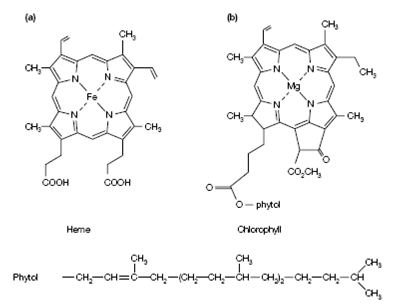Tetrapyrroles:
The green chlorophyll and red heme pigments, so important in the energy- producing mechanisms of photosynthesis and respiration, are both members of the family of pigments called tetrapyrroles. They share same structures like in given below figure, and have some general steps in their degradation and synthesis.

Figure: Structure of (a) heme and (b) chlorophyll.
The simple structure of a tetrapyrrole is four pyrrole rings surrounding a middle metal atom.
Hemes are a diverse set of tetrapyrrole pigments and being present as the prosthetic group of both the globins hemoglobin and myoglobin and the cytochromes (involved those included in photosynthetic and respiratory electron transport and the cytochrome P450s which are used in detoxification reactions. Some enzymes, involving the peroxidases and catalases, contain heme. In all these hemoproteins the function of the heme is either to bind and release a ligand to its middle iron atom or for the iron atom to undergo a modification in oxidation state and releasing or accepting an electron for participation in a redox reaction.
The chlorophylls are also a diverse family of pigments existing in variant forms in photosynthetic algae, bacteria and higher plants. They share a general function in all of these organisms to act as light-harvesting and reaction middle pigments in photosynthesis. This function is achieved through a number of modifications to the simple tetrapyrrole structure. These involve: the insertion of magnesium as the middle metal ion, additionally of a fifth ring to the tetrapyrrole structure and loss of a double bond from one or more of the pyrrole rings and binding it of one specific side-chain to a long fat-like molecule known as phytol. These modifications provide bacteriochlorophylls and chlorophylls a number of useful properties. For instance, chlorophylls are membrane bound, absorb light at longer wavelengths than heme and are able to respond to excitation through light. In that way chlorophylls can accept and release light energy and drive photosynthetic electron transport.